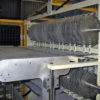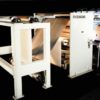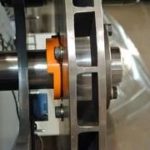Quality and service have been instrumental in an Illinois converter’s growth from a small plastics distributor and converter to an extrusion specialist with state-of-the-art converting facilities.
Lustro, Evanston, IL, supplies the offset-printing industry with sheeted film products and has a worldwide customer base. End-use applications included transparencies, overhead projections, book inserts, greeting-card over-lays, and point-of-sale materials.
Sheeting is an important part of the operation. For the past 30 years, Lustro’s sheeting operation has been performed in-house on three sheeters. From roll form. The film is sheeted with a tissue interleave and then cut to the customer’s specifications on one of three guillotine trimmers.
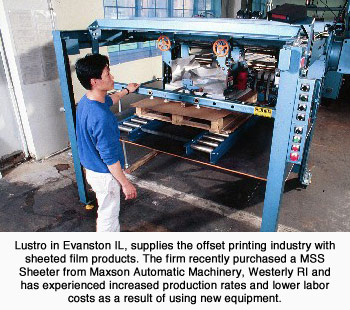 This method had been successful for Lustro until recently when one of the sheeters had to be replaced. This development prompted the firm to examine the efficiency of its sheeting operation.
This method had been successful for Lustro until recently when one of the sheeters had to be replaced. This development prompted the firm to examine the efficiency of its sheeting operation.
“Sheeting was the area needing the greatest improvement,” Phil Scully, Lustro’s sales and service manager, said. “Our sheeting equipment was quite old, operated at slow speeds and wasn’t very accurate. There’s simply too much competition around not to keep up with the times, so we decided to investigate the new technologies available in sheeting equipment.”
The company identified several criteria for selection, including speed, accuracy and a reasonable price. After considering six sheeter designs, the equipment that met all of the MSS sheeter from Maxson Automatic Machinery, Westerly, RI.
“The Maxson’s production capabilities excited us, but, in addition, we were impressed with the unit’s many innovative design features. These included the use of air at the stacker to help float out the sheets as well as a feed-down table designed to automatically lower the skid as pile height increases.”
The new sheeter features a variable-speed transmission that provides a sheet-length and squareness accuracy of + .03 in. A slitter rig and sheet length monitor were also selected as equipment options to further improve accuracy and efficiency.
The sheet-length monitor eliminates setup waste by allowing the operator to preset the sheet length before threading the web into the cutter. When the sheeter is in operation, the monitor digitally displays the sheet length to the nearest hundredth of an inch. As a result of these options, Lustro has realized a 25% reduction in waste.
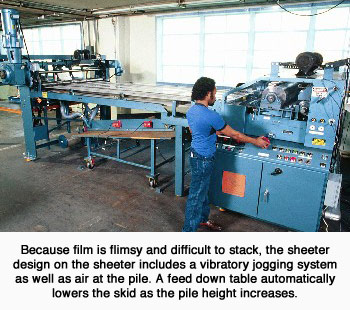
The sheeter is also equipped with a reject gate, which was originally designed to divert unacceptable sheets during setup. However, the firm found another application for this reject gate once the sheeter was in operation. “We use the reject gate far more often to divert good sheets for 1 or 2 sec. while the operate places a clipboard insert at the pile,” Scully said.
Because film is flimsy and difficult to stack, the design of the new sheeter includes a vibratory jogging system at the stacker. The jogging system is reported to have significantly improved the overall quality of the stack. “On our older equipment, our operator would have to flight with the stack before trimming,” Scully said. “The skids off the Maxson are neatly jogged and easier to work with, and we estimate a 10% time savings in not having to restack the material at the trimmer.”
The Maxson sheeter at Lustro runs within a speed range of 225 fpm to 240 fpm, which is twice as fast as the unit it replaced. This speed gain has doubled the company’s production rates. On their old sheeter, a run of 325,000 sheets required more than 200 hr. of machine time. A similar run on the new sheeter is completed within 100 hr.
In terms of throughput, “we’re still faced with a two-week backlog, but the big difference now is what you can do in those two weeks,” Scully said. “Because of the sheeter’s production capabilities, we use the new sheeter to handle long runs. Our operator can set it, and, for the most part, forget it.” Lustro’s remaining sheeters are used primarily for short runs.
Labor costs have also been reduced since the new unit was purchased. Its compact design offers ease of operation. Lustro operates it with one skilled operator is required to operate each of the old sheeters.
The new equipment has also been a motivating factor for Lustro’s employees. “Our operators treat it like a whole new entity, and it has instilled a certain amount of pride among the employees.”
In addition to improving overall productivity, the Maxson sheeter at Lustro has opened up opportunities for growth. “We now have more flexibility to take on certain jobs that we couldn’t do in the, “Scully said. ” For example, we now have the capability to sheet flexible vinyl, and we can do it faster and with less labor requirements.”
Reprinted from Paper Film Foil Converter, December 1989


